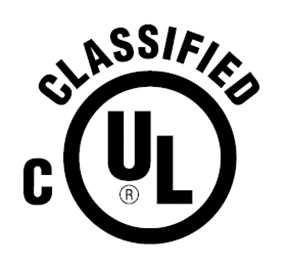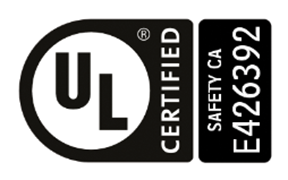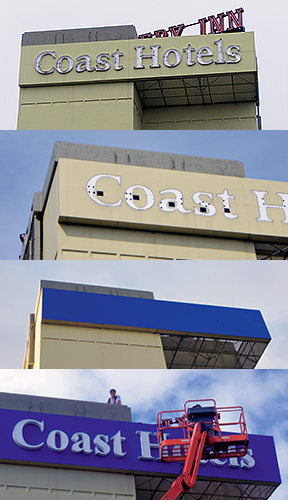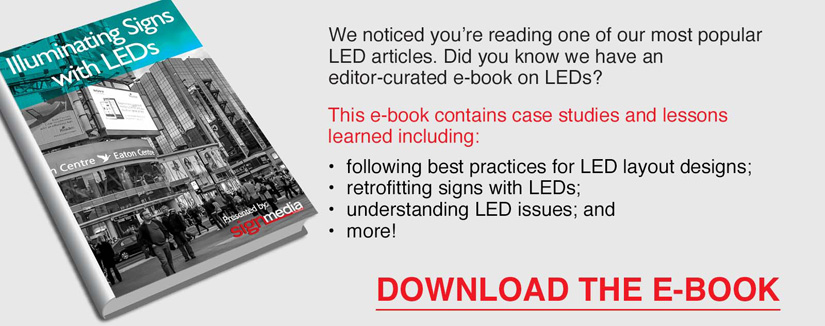Illumination: LED kits for sign retrofits
by all | 11 February 2015 10:30 am
 [1]
[1]Photos courtesy Grant Illuminated Signs
By Pierre McDonald
With energy prices on the increase, many utility grids reaching capacity and some existing power generation facilities in Canada nearing their end of useful life, business owners and consumers alike have become vigilant in finding new ways to reduce their carbon footprint. It has become increasingly important to lower energy consumption in all areas, including the sign industry.
New technology for sign lighting continues to evolve to meet these energy reduction demands, but existing sign installations cannot simply all be replaced with new ones. Rather, the industry needs ways to make existing signs more efficient. Light-emitting diode (LED) kits for sign retrofits have helped meet this need, but it is important to use only kits certified for safe use.
Certification
All provincial and territorial jurisdictions across Canada require electrical products to be certified by a certification body (CB) accredited by the Standards Council of Canada (SCC). As such, the CBs test electrical equipment to a national standard—or a number of national standards—and also inspect that equipment’s manufacturing process on a routine basis in order to ensure compliance with the appropriate standards. Upon approval, the CBs allow their mark to appear on the equipment as proof of compliance to those standards. This certification mark must appear on all electrical products for them to meet provincial and territorial requirements.
Underwriters Laboratories (UL), which provides safety consulting and certification services, currently has seven categories associated with sign products, which are used to evaluate equipment to meet Canada’s jurisdictional requirements:
- UXYT7—Signs Certified for Canada.
- UYAM7—Field-installed Neon Outline Lighting Systems Certified for Canada.
- UYFS7—Signs, Changing Message Certified for Canada.
- UYMR7—Sign Accessories Certified for Canada.
- UYTQ7—Sign Controllers, Message Centers Certified for Canada.
- UYWU7—Sign Conversions, Retrofit Certified for Canada.
- UYZZ7—Sign Flashers Certified for Canada.
- UZBL7—Skeletal Neon Sign and Outline Lighting Systems, Field-assembled, Certified for Canada.
 [2]
[2]Figure 1: Identifies a UL-listed product of Canada.
While six of the above categories specifically cover equipment for new installations, the other—UYWU7, ‘Sign Conversions, Retrofit Certified for Canada’—will meet SCC CB requirements and allow sign owners to bring their existing infrastructure up-to-date with newer technology. (Information associated with each of these product categories can be obtained from UL’s online directory, database.ul.com, simply by entering the category codes listed above in the appropriate box and clicking ‘search.’)
Requirements and markings
The retrofit sign conversion category covers subassemblies or kits intended for field installation in certified signs. There are several specific types of sign conversions in this context.
Scrolling units (i.e. motor-operated message assemblies), devices that change the type of illumination (e.g. from incandescent to fluorescent) or combinations thereof are among these subassemblies intended for field installation in specific, certified, permanently connected electric signs. This type of conversion must identify the catalogue number or other description and the company name for the sign in which it is intended to be used.
 [3]
[3]Figure 2: UL enhanced mark, since 2013. (Also indicates Canadian conformity, with ‘CA’ as the Canadian identifier).
An LED retrofit kit, meanwhile, includes the LEDs themselves, a power source and a mounting assembly or other means of changing the type of illumination originally contained within a sign to an LED system. The kit’s installation instructions must specify the type of sign in which these components are intended to be installed.
All of these conversion options have been investigated to determine that, when used in accordance with the manufacturer’s instructions provided with the retrofit device or system, they will not adversely affect the operation of the complete electric sign. To obtain certification for use in the Canadian market, these kits must meet the requirements of the appropriate Canadian standard. (This could be a standard published by an organization other than CSA. There are now eight accredited standards development organizations in Canada, all of which can write product standards.)
The main standard by which products in this category are investigated is CAN/CSA-C22.2 No. 207, Portable and Stationary Electric Signs and Displays. UL provides classification marks and certification marks to identify these manufactured products, through its certification and followup service.
See Figures 1 and 2 for the two marks that can appear on retrofit kids, plus the additional certification markings required. Over the next eight to 10 years, the UL classified mark will be phased out, in favour of the enhanced mark.
 [4]
[4]Depending on the situation, channel letters may need to be removed and retrofitted in the shop before reinstalling them in the field.
AHJs and retrofits
While the use of certified electrical products is mandatory in all provinces and territories, the ‘authority having jurisdiction’ (AHJ) will, in certain cases, impose additional requirements to ensure product certification is maintained within its area.
The use of a certified retrofit kit for signs— if it is approved for the type of sign and application in which it is to be installed and if it is installed as per the manufacturer’s instructions and in accordance with provincial or territorial legislation—would be acceptable for most AHJs ‘as is.’ Some AHJs, however, mandate an additional special inspection (SI), which must be performed before the installation can be accepted.
An SI is an assessment of electrical products in the field to determine their suitability for a given installation. It is performed as per CSA’s SPE-1000, Model Code for the Field Evaluation of Electrical Equipment.
Predominantly, an SI is used to allow equipment that is not certified or does not have a certification program to be accepted. Inspection bodies for this purpose must be accredited by SCC to be recognized by the provincial or territorial jurisdiction. (A list of all accredited inspection bodies can be found on SCC’s website, www.scc.ca.)
In cases where signs are being upgraded or modified without the use of an approved retrofit kit, AHJs are diligent in inspecting the installations, as they are well-aware of this practice. For the most part, these installations are rejected due to their use of uncertified components, but an SI is the only avenue by which they may potentially be accepted. The acceptance of an SI is and has always been at the discretion of the relevant AHJ.
Code references to AHJs
In Canada, every province and territory has adopted and continues to enforce the same installation code—CSA C22.1, Canadian Electrical Code (CEC)—although some do so with amendments. Regulatory authorities have been extremely active in the development of CEC over the years.
Section 34 of CEC covers the requirements for the installation of signs and outline lighting. While this section primarily provides direction for new installations, it should also be referenced for the installation of retrofit kits, as the certification of these kits is contingent upon the installation meeting both the manufacturer’s instructions and the requirements of CEC.
Specific requirements in Section 34 include the locations of signs and outline lighting, disconnecting means and supporting means. Additional rules are in place to cover thermal and overcurrent protection, grounding and bonding, enclosures, neon supplies and wiring methods.
Generally, the administration and adoption of CEC has been addressed at the provincial and territorial level, whereas the enforcement of CEC may be addressed at the provincial and/or municipal level. So, further information about CEC and specific requirements for the installation of retrofit kits in each jurisdiction can be obtained by contacting the appropriate provincial or territorial authority, which UL lists online.
With advances in lighting technology continuing to provide more energy-efficient LEDs and related products, it has become more difficult to navigate both regulatory requirements and product certifications in Canada. Fortunately, in response to such concerns, UL and other organizations are collecting the appropriate information online and offering assistance, interpretation and regulatory details.
Pierre McDonald is an Edmonton-based senior regulatory representative for Underwriters Laboratories Canada (ULC). For more information, contact him via e-mail at pierre.mcconald@ul.com.
- [Image]: http://www.signmedia.ca/wp-content/uploads/2015/02/IMG_2300.png
- [Image]: http://www.signmedia.ca/wp-content/uploads/2015/02/cul.png
- [Image]: http://www.signmedia.ca/wp-content/uploads/2015/02/ulc.png
- [Image]: http://www.signmedia.ca/wp-content/uploads/2015/02/edited1.jpg
Source URL: https://www.signmedia.ca/illumination-led-kits-for-sign-retrofits/

